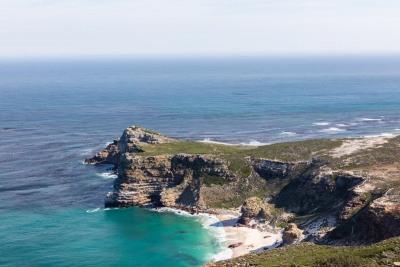Johan Anthoniszoon "Jan" van Riebeeck (21 April 1619 18 January 1677) was a Dutch navigator and colonial administrator of the Dutch East India Company.
The Cape of Good Hope (Afrikaans: Kaap die Goeie Hoop [ˌkɑːp di ˌχujə ˈɦuəp]; Dutch: Kaap de Goede Hoop [ˌkaːb də ˌɣudə ˈɦoːp] (listen); Portuguese: Cabo da Boa Esperança [ˈkaβu ðɐ ˈβoɐ (ɨ)ʃpɨˈɾɐ̃sɐ]) is a rocky headland on the Atlantic coast of the Cape Peninsula in South Africa.
A common misconception is that the Cape of Good Hope is the southern tip of Africa, based on the misbelief that the Cape was the dividing point between the Atlantic and Indian oceans. In fact, the southernmost point of Africa is Cape Agulhas about 150 kilometres (90 mi) to the east-southeast. The currents of the two oceans meet at the point where the warm-water Agulhas current meets the cold-water Benguela current and turns back on itself. That oceanic meeting point fluctuates between Cape Agulhas and Cape Point (about 1.2 kilometres (0.75 mi) east of the Cape of Good Hope).
When following the western side of the African coastline from the equator, however, the Cape of Good Hope marks the point where a ship begins to travel more eastward than southward. Thus, the first modern rounding of the cape in 1488 by Portuguese explorer Bartolomeu Dias was a milestone in the attempts by the Portuguese to establish direct trade relations with the Far East (although Herodotus mentioned a claim that the Phoenicians had done so far earlier). Dias called the cape Cabo das Tormentas ("Cape of Storms"; Dutch: Stormkaap), which was the original name of the "Cape of Good Hope".As one of the great capes of the South Atlantic Ocean, the Cape of Good Hope has long been of special significance to sailors, many of whom refer to it simply as "the Cape". It is a waypoint on the Cape Route and the clipper route followed by clipper ships to the Far East and Australia, and still followed by several offshore yacht races.
The term Cape of Good Hope is also used in three other ways:
It is a section of the Table Mountain National Park, within which the cape of the same name, as well as Cape Point, falls. Prior to its incorporation into the national park, this section constituted the Cape Point Nature Reserve.
It was the name of the early Cape Colony established by the Dutch East Indies Company in 1652, on the Cape Peninsula.
Just before the Union of South Africa was formed, the term referred to the entire region that in 1910 was to become the Cape of Good Hope Province (usually shortened to the Cape Province).

1652Apr, 6
At the Cape of Good Hope, Dutch sailor Jan van Riebeeck establishes a resupply camp that eventually becomes Cape Town.
Choose Another Date
Events on 1652
- 6Apr
Jan van Riebeeck
At the Cape of Good Hope, Dutch sailor Jan van Riebeeck establishes a resupply camp that eventually becomes Cape Town. - 7Sep
Guo Huaiyi Rebellion
Around 15,000 Han farmers and militia rebel against Dutch rule on Taiwan.

 English
English  español
español  français
français  português
português  русский
русский  العربية
العربية  简体中文
简体中文 